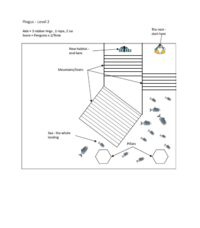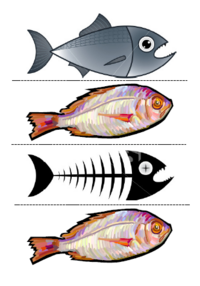Pingus
| Pingus | |
|---|---|

| |
| Designer: | Simon Katan |
| Year: | unknown |
| Players: | 10,12 or 14 |
| Stuff required: | equal numbers of bibs in two colours, 3 rubber rings, a length of thick rope, 2-4 blocks of polystyrene, 3 umbrellas, 20 cut out fish, masking tape, stopwatch, clipboard. |
| Crew required: | 1 or 2 people. |
| Preparation: | 1hr (prior site visit essential) |
| Time required: | 15 mins per course. (2-3 courses per game) |
| Place required: | anywhere with lots of stairs, people, nooks and crannies. |
| Activities: | strategy, teamwork, moving, fast reactions. |
| This is a playable game - it's finished, tested and ready to play. | |
| This game is made available under an Attribution-Noncommercial Creative Commons licence. (What does this mean?) | |
Pygoscelis Adeliae Pingus, an endangered and extremely rare breed of penguin with a population of just 10 to 14 remaining in the wild. That even this many survive is one of evolutions' great anomalies as the species is not only particularly poorly adapted to its environment - it can't fly, swim or climb - but Adaliae Pingus also exhibits what can only be described as a suicidal tendency. Its up to you and your team of dedicated environmentalists to save the species
How to play
Split into two teams of equal numbers. For every course, each team will take a turn at being penguins whilst the other team is environmentalists. Before the game begins all players must learn about penguin behavior as described below...
- Penguins walk by taking a large step forward with a fully extended leg then bringing both feet together and flapping their wings (i.e. hands against sides) two times.
- Penguins don't stop or change direction unless guided or startled.
- If a penguin walks into an inanimate object such as a table, chair or wall, they die.
- If a penguin walks into an obstacle without the appropriate aid (eg. walk into the sea without a rubber ring) they die.
- If a penguin walks into a member or the general public or is guided badly by and environmentalist they get startled and may proceed in any direction the penguin wishes. (Penguins aren't startled by each other)
- If a penguin passes near a fish they pick it up.
- Dead penguins can't have any effect on the world.
The environmentalists must guide the penguins from their nest to the sea, where the penguins will feed, and then either return them safely or lead them on to a new habitat. (depending on course layout).
- Environmentalists can change a penguin's direction by creating a corner formation. This involves two environmentalists extending their arms fully and creating a physical corner for the approaching penguin with one side being in the current direction of the penguin and the other indicating the new direction in which the penguin must travel. (A single environmentalist trying to turn a penguin will simply startle them)
- One environmentalist should guard the nest whilst there are penguins there and release them when they want. If there is no environmentalist there the penguins will release themselves.
- Environmentalists will have a number of aids to help penguins negotiate obstacles that are in their path. They can give and take these from the penguins at any time. With the exception of the rope all aids can only be used by one penguin at a time.
- Rubber rings - for crossing sea
- Rope - for climbing mountains (i.e stairs). This must be held at the top by an environmentalist but many penguins can use it at the same time.
- Ice (polystyrene) - freezes the penguin who is holding it
- Umbrella - for descending cliffs (i.e. going downstairs)
- Hard hats - for crossing crevasse fields.
The score is determined by the number of alive and fed penguins that get to the end of the course divided by time. (Beware this results in a decimal scoring system so the game runner will need a calculator). On longer courses the number of remaining penguins can be multiplied to compensate for the larger time divisor.
Set Up
The main task of setting up the game is course design. A large amount of the mechanic is created by the course layouts so its worth spending a fair amount of time thinking about this. I would recommend a site visit prior to the day and walking through the course with a stop watch to estimate timings. Also gradate your courses, gradually introducing more obstacles and aids so that you don't have to explain all the rules at the beginning. Try to use the geography of the building you're in as much as possible to determine the course (eg. this landing is all sea), but where necessary mark things out by putting masking tape on the floor.
The game is much harder than you would think so be sparing with the obstacles. Decide on how many aids the environmentalists should get for each course. As a general rule you are trying to create a certain degree of stress so where obstacles are next to each other give uneven numbers of aids as this will create interesting dilemmas for the environmentalists. If your course is quite long make sure you add a multiplier to the scoring system otherwise the environmentalists won't be motivated to save the penguins. I've attached the courses that I used at a recent Sandpit at the Southbank as examples as well as the fish to be cut out and laminated.
GNU Inspiration
Was inspired by the GNU computer game of the same name [1] which is itself a publicly licensed version of Lemmings(tm). In the spirit of GNU, I encourage modification and addition of rules. Please let me know if you run your own version.

